#and the telltale sign is always that the protagonist has no personality other than wanting to be a girlboss
Text
no more generic tongue-in-cheek fairytales where the girl wants to become a ceo instead of a princess im begging ur not enchanted ur never gonna be enchanted
#not su /#yes i saw that awful amazon cinderella trailer lol#i'm so tired of this narrative#chasing dreams and working hard is fine as morals but just... this version of it is so lazy and annoying#and the telltale sign is always that the protagonist has no personality other than wanting to be a girlboss#its so toothless and capitalist it doesnt do anything against gender roles or subvert expectations its just girlboss for the sake of it#meanwhile giselle is like one of the best disney princesses with an arc who doesnt start out wanting to be a dressmaker#but it totally makes sense with her and her personality and amy adams killed it and nobody knows how to replicate apparently#cuz everyone from belle in the live action remake to the new amazon cinderella just has generic girlboss personality and it sucks
149 notes
·
View notes
Text
A closer look at the interaction between Rukawa Kaede and Sakuragi Hanamichi
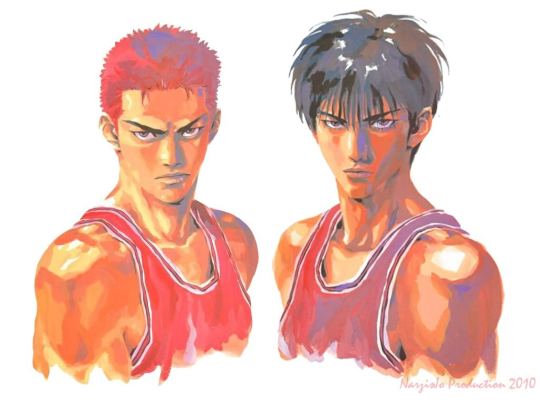
As discussed in my previous essay, Sakuragi Hanamichi and Rukawa Kaede truly share an undeniably unique bond. In fact, the natural progress of their relationship is one of the layers in their character development as well as one of the main themes of the story. Since my first essay focuses on the impact of Sakuragi on Rukawa, I decided to leave out some scenes that don't highlight the purpose of the essay. This time, I would like to analyze in detail some memorable scenes between these two which haven't been previously examined.
Being the protagonist of the manga, Sakuragi is always the center of almost all relationships which are essential to the plot. However, not all relationships revolving around him hold the same degree of importance to his growth as a character. The clearest example is the differences between the scenes in which he meets Haruko and Rukawa for the first time.
The first thing we need to establish is that Sakuragi's crush on Haruko is crucial to the plot of the story since he only joins the basketball team to impress her. However, their relationship mostly serves as the comedic relief for the series and the cause of Sakuragi's discontent towards Rukawa. For the most part, Haruko doesn't really leave much of an impact on Sakuragi like Rukawa does, and there are not many examples that demonstrate she understands Sakuragi on a personal level either.
Even their first meeting reflects this very fact.
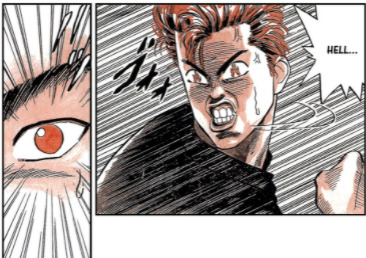
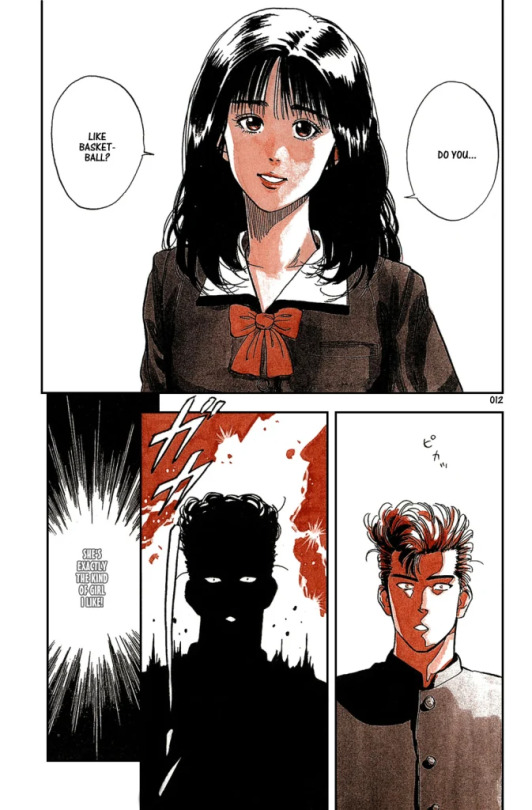


Sakuragi gundan-the usual spectators/commentators
Sakuragi struck by "love at first sight" (with lightning in the background and his goofy expression) is a classic example of comedic relief in Japanese manga in the 90ss. His 180° change in attitude towards basketball right after his meeting with her in this scene is also a telltale sign of the nature of their relationship: not serious, a teenage crush.
Compared to the Sakuragi's first meeting with Haruko, the reader can really feel the weight of his first encounter with Rukawa. If I could choose one word to describe the moment Sakuragi and Rukawa first see each other, "dramatic" is the first word I'd use. There are a couple of techniques that are utilized here. Let's examine them in detail.

First panel: Sakuragi is standing behind his friends
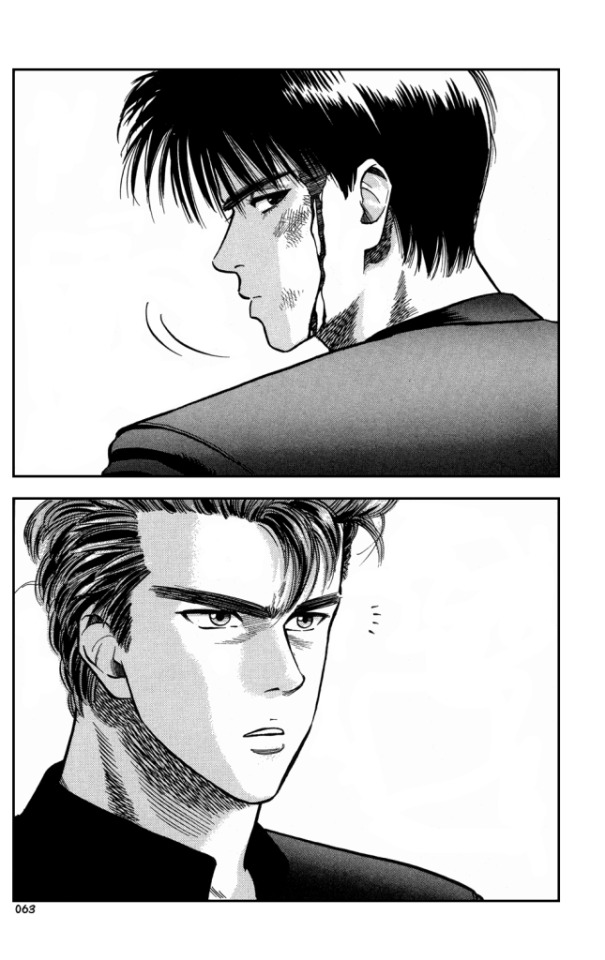
Second panel: One whole page of Sakuragi and Rukawa acknowledging each other's presence
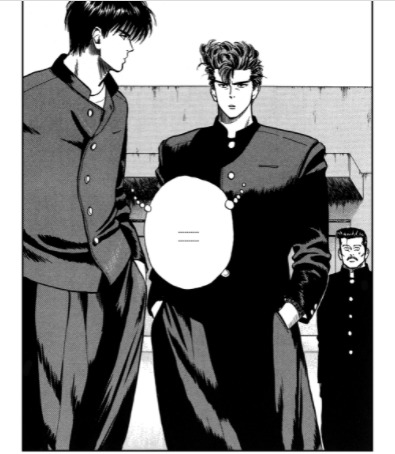
Third panel: Sakuragi’s now separated from the rest of his group
It's already established that Rukawa is an important character since the title of chapter 2 itself is his full name, and his back, his eyes are repeatedly shown to the reader. The scene above doesn't highlight the fact that Rukawa is one of the main characters of the series, but the relationship he is about to share with Sakuragi. Notice that in the first panel, Sakuragi is behind his friends. Here, he is only one of the spectators.
In the second panel, we have a full page of Sakuragi and Rukawa being aware of each other's presence (the frame zooms into their faces only). This is a common technique utilized in manga or even in movies/TV series when an interaction between 2 characters needs to be highlighted. In the third panel, notice that Sakuragi is suddenly not behind his friends anymore. Somehow, Sakuragi has separated from the rest of Hanamichi gundan even though we never see when he steps away from his friends. This implies that he is no longer a mere spectator like in the first and second panels. Sakuragi and Rukawa are now the only 2 active participants in the scene while his friends are spectators/commentators who fade away in the background.
The "camera lenses" also stay on the 2 characters a bit longer than usual (neither Sakuragi nor Rukawa initiates the conversation in the third panel although they already see each other in the second panel). This technique is usually deployed when the author wants to emphasize the tension between 2 characters or to foreshadow the future dynamic between them. In Sakuragi and Rukawa's case, it's both.
Of course, this is not the only time their interaction is highlighted. We see this technique once again in the final match with Sannoh, when Sakuragi and Rukawa have a breakthrough in their tacit communication.
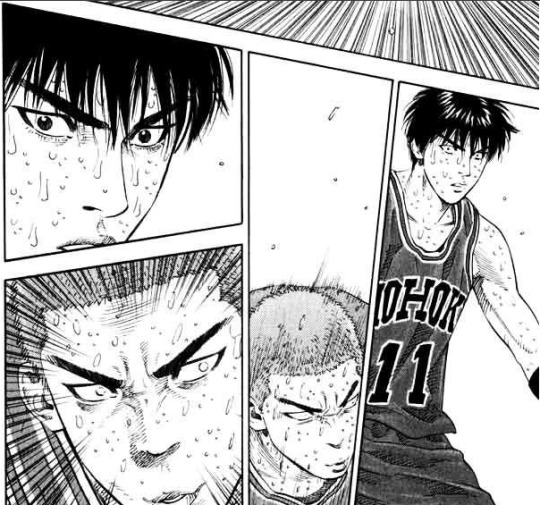
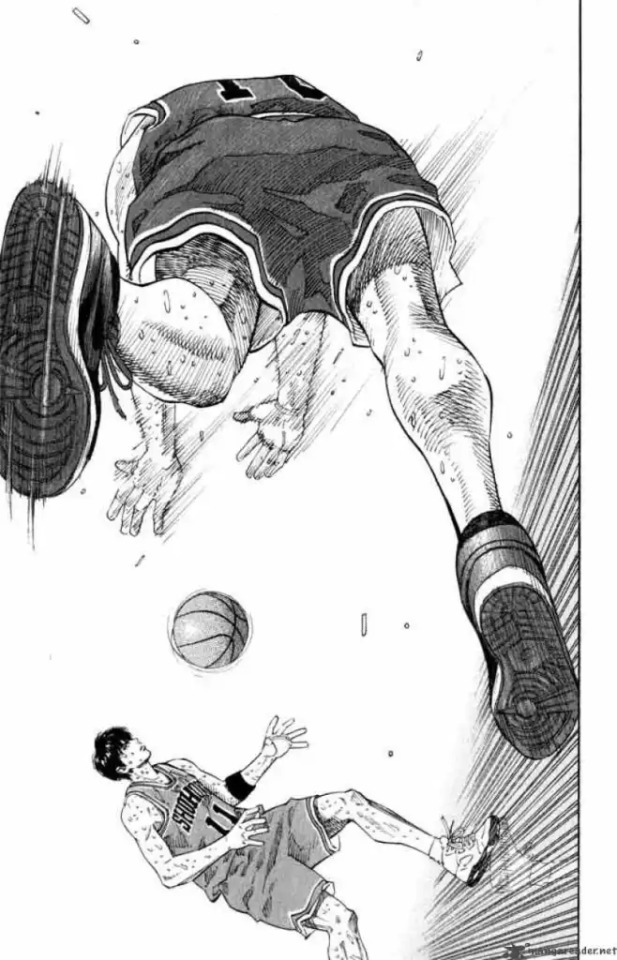

There is no doubt that this moment is an important buildup to the climax of the whole manga. Just like how instrumental Sakuragi and Rukawa's first encounter is, the scene above is equally crucial to the plot because it calls attention to their very first successful attempt to cooperate with each other. Inoue sensei again chose to zoom into their faces to highlight this pivotal point of the characters' interaction. Sakuragi and Rukawa's relationship has just turned over a new page.
However, being the masterpiece that it is, Slam Dunk is full of scenes that are jam packed with details and layered with meaning. The scene above is no exception. It's not just about Sakuragi and Rukawa's relationship but also highlights two layers of Sakuragi's character development: 1. His trust in Rukawa and 2. His willingness to cooperate with Rukawa. It takes him 273 chapters to finally make a pass to his "archenemy" and the pass is utterly breathtaking because it underlines that this time, Sakuragi consciously recognizes Rukawa's ability to score for Shohoku at a critical moment. Even more importantly, this scene indicates that Sakuragi is willing to let Rukawa score, instead of trying to show off. We, as readers, once again can truly feel the importance of the moment when Sakuragi and Rukawa's faces and expressions are the center of focus in the same frame.
We know that in the initial phase of their bond, Rukawa is often forced to teach Sakuragi basic techniques on the spot. Although we can hardly say that Rukawa is Sakuragi's mentor, the one person Sakuragi always has his eye on is Rukawa himself. Over the course of the story, Sakuragi receives instructions and guidance from various players (the other 3 Shohoku regulars and even some other players from opponent teams help him in some ways), however, Rukawa is still the only player that Sakuragi personally watches and follows.
But Rukawa doesn't only teach Sakuragi basic techniques, he also points out certain things to Sakuragi in the harshest way possible. While Akagi, Miyagi and Kogure soften up their tone from time to time, Rukawa is always brutally honest to Sakuragi, there is never an instance he sugarcoats his words.
Even when he wants to help Sakuragi regain his composure, this is how he communicates with Sakuragi.
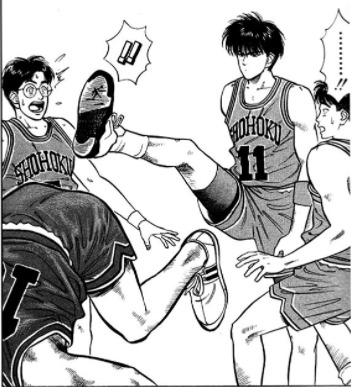

Rukawa kicking Sakuragi from behind and calling Sakuragi "Dou ahou" in the friendly match with Ryonan

Rukawa calling Sakuragi a chicken for being afraid of Shoyo's defence
Or when he "consoles" Sakuragi after the loss against Kainan. (I already analyzed this scene in my previous essay, I won't repeat myself again here).

Obviously, Rukawa doesn't behave like this towards Sakuragi only. He even shows his senpai the same attitude before he sees for himself how well they play. However, what I would like to focus here is the fact that it always works wonders on Sakuragi. Compared to the strict Akagi, the lenient Kogure and Sakuragi's pal Miyagi, Rukawa's words always seem to work better on Sakuragi in critical moments. Let's look at one example of how Miyagi talks to Sakuragi and how Rukawa communicates the same thing.


Notice that when Miyagi mentions, "Ryonan is focusing their attacks on Fukuda", Sakuragi is visbily confused (denoted by .....?). A newbie like him doesn't really know anything about defence strategies, so it's understandable that he cannot comprehend the point Miyagi is trying to get across, not to mention that he is too dense to understand what Miyagi is hinting at anyway. It takes Rukawa who is always mercilessly frank to help Sakuragi catch up with the situation.
There is another instance when Rukawa irks Sakuragi with his deliberate choice of words that I find interesting.


This scene is from chapter 260, when Rukawa accidentally crashes into Sakuragi when he's trying to break free from Sawakita's defence. What's interesting here is that the way he puts it ("everyone already knows a newbie like you will make mistakes. Like paying taxes, it's unavoidable") is very similar to when he "comforts" Sakuragi after their loss against Kainan ("your mistakes were calculated and expected from the beginning", chapter 133).
The scene from chapter 260 reveals that Rukawa's opinion about Sakuragi hasn't changed much. He still doesn't trust that Sakuragi can actually score even if he passes to him. Rukawa's lack of trust in Sakuragi isn't unreasonable. Sakuragi may be the Rebound King of the whole series, but when it comes to scoring, he is obviously not the best player on court. Not only that, Rukawa is absolutely right that Sakuragi is still a newbie. Therefore, it's no wonder Rukawa wouldn't pass to him.
While Rukawa's attitude towards Sakuragi hasn't changed in this scene, Sakuragi's attitude is actually slightly better. Seeing how Rukawa starts cooperating nicely with other teammates, Sakuragi immediately assumes that Rukawa would do the same with him. Here, he starts thinking about playing cohesively as a team, and not just about his own individual play. Although the assumption comes from his own delusion about his abilities and Rukawa's willingness to work with him, this is the very first time Sakuragi actually attempts to improve their tacit understanding (i.e: the ability to cooperate without having to discuss beforehand).
Even though Rukawa doesn't trust Sakuragi until the very last chapter of the series, we know that he does take Sakuragi seriously from time and time. Of all Slam Dunk characters, Rukawa can be said to have the toughest mentality. He's almost never affected by verbal provocations and is always able to keep his head cool on court. There's more than one instance that demonstrates instigation/intimidation tactics are completely useless against Rukawa, even if it's from Sawakita.
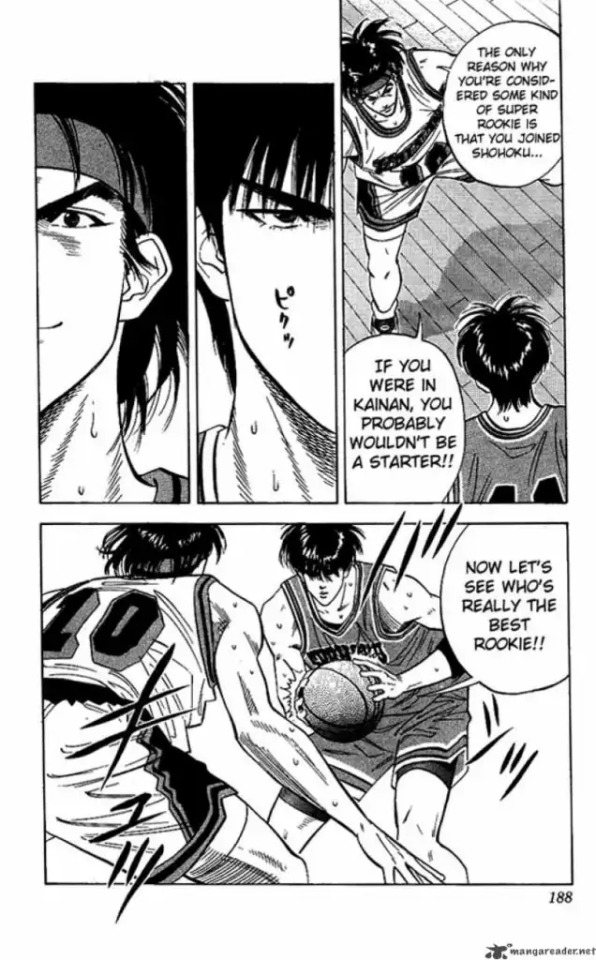
Rukawa shows no reactions to Nobunaga's intimidation

Minami: "Can't tell the distance, right?/You should've stayed on the bench" after he intentionally injures Rukawa. Yet, Rukawa pays him no mind


Rukawa completely ignoring Sawakita, and only focusing on the game
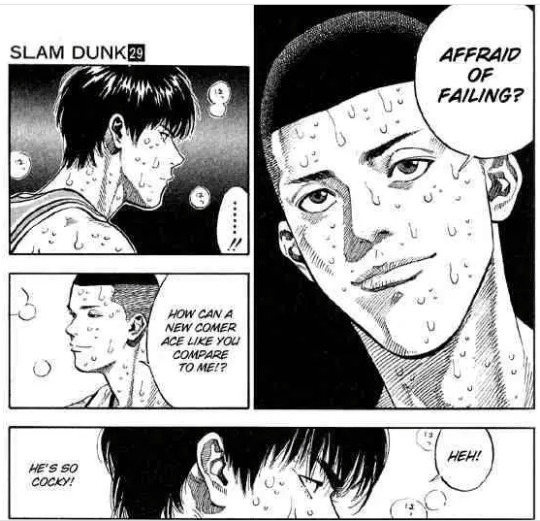
Rukawa unfazed by Sawakita’s intimidation, he shows no change in attitude whatsoever
Throughout the whole manga, there are only 2 characters that can provoke Rukawa. One is Sendoh Akira.


Rukawa letting Sendoh's provocation get into his head in his very first match in high school
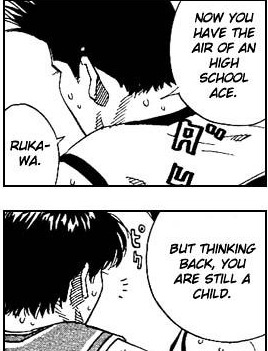

Sendoh succeds in getting a reaction out of Rukawa in their official match
And the other is Sakuragi.

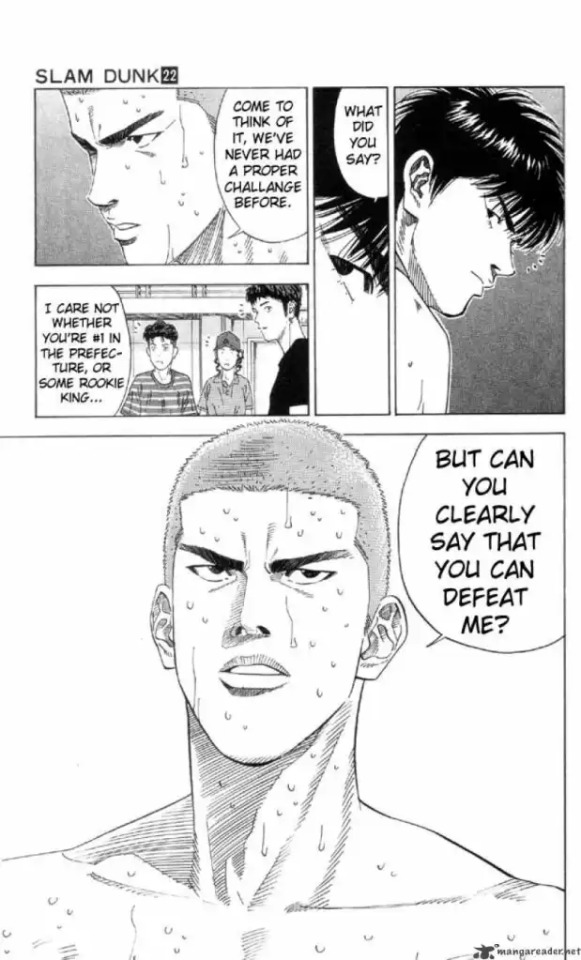
Sakuragi challenging Rukawa to an one-on-one match and Rukawa accepts the challenge

Rukawa ignoring Sawakita, but getting riled up by Sakuragi's remark

Rukawa claiming he will defeat Sendoh but clearly trying to provoke Sakuragi, not Sendoh
I tend to think that as time passes, Rukawa also improves his mentality on court, not just his technical skills. So it makes sense that when Shohoku enters national championship, coach Anzai doesn't even need to check up on Rukawa's mentality while he makes sure to do so for the other four Shohoku regulars. Thus, it's quite intriguing that Sakuragi can have such an effect on Rukawa that almost no star players can.
In summary, Sakuragi and Rukawa's relationship is indeed central to the plot of the story. As well, their interactions serve as a model testament to each character's growth and development as basketball players. Throughout the series, we can clearly see how they gradually grow to care about each other as teammates and eventually to acknowledge one another's abilities in order to successfully cooperate for their common goal. Their bond never feels forced, neglected or not developed enough since both characters show significant progress to overcome prejudice against each other. It's not an overstatement to claim that Sakuragi and Rukawa's relationship is truly the "gold standard" of shonen manga as their archetypes and dynamic surely stand the test of time.
#Slam Dunk#Slam Dunk anime#Slam Dunk manga#Sakuragi Hanamichi#Hanamichi Sakuragi#Rukawa Kaede#Kaede Rukawa#桜木 花道#流川 楓#Inoue Takehiko#sports manga#basketball#character interaction analysis#スラムダンク
93 notes
·
View notes
Note
(1) Something I dislike about the Kid Icarus fandom and to an extent the smash bros fandom is how they tend to portray Dark pit as an edge lord and pit into an over simplistic dumb shonen protagonist when the very existence of dark pit demostrares the contrary and hints to Pit possessing hidden depths including some sort of internalized self doubt/hatred.
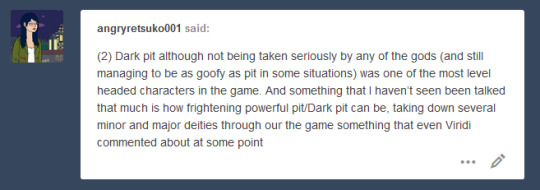
Yeah, I get what you mean. I can forgive the Smash Bros fandom for misinterpreting the characters if they just haven’t played Uprising, though, since then all they have to go off of are those dialogue easter eggs. (Which don’t really go into depth on their personalities since, y’know, they’re just meant to be funny.)
This is the fandom that was convinced Marth was a super flamboyant, egotistical guy for years based on his body language and a mistranslation of his taunt, after all. It’s not too surprising that they mistake Pit for just a simple shonen protagonist and think Dark Pit is just his edgy/evil clone. I mean, just looking at Dark Pit with no context does give off a villainous vibe.
I understand feeling miffed at the Kid Icarus fandom, though. Misinterpretations seem to be abundant in every series, but it’s still frustrating when these two characters are actively subverting their own tropes only to be thrown back into them by the fandom.
I’m gonna have to put the details under a cut because once again, I’ve proven myself to be incapable of talking about these characters for a short amount of time.
I mean, Pit? Yeah, he has a lot of typical shonen qualities, but one thing he’s not is oblivious. He gives off a strong impression of knowing exactly how everyone feels about him and tends to react accordingly. Except in regards to Palutena, who he’s clearly emotionally dependent on. Actually, his relationship with Palutena in general isn’t one I’ve seen a lot in shonen anime, which automatically makes him stand out to me.
The point is, Pit is a lot sharper than anyone (even in the game itself) gives him credit for. And I don’t quite understand how some people can play the game so much and still mostly see him as the “cute dumb anime guy.”
Like, he can have hilarious moments like eating ice cream off the floor and randomly saying he’d like to be a goldfish and still be a serious character with issues of his own. People are more than just their sense of humor, and Uprising demonstrates this even stronger with Dark Pit.
Oh, Dark Pit. I feel like I’ve been seeing him grouped with the other villains of Smash Bros more often lately, and I just… no. Guys. That’s literally ignoring the entire point of his character, why are you doing this.
Uprising has tons of twists on its default structure. You get to the credits and a new villain shows up out of nowhere and tears that screen apart. You possess a dog. The menu changes pretty far in the game to match what’s happening in the plot. You go a whole chapter without playing Pit because he’s dying from a far more graphic injury than anything you’ve seen in the game so far.
And Dark Pit? He has all the initial telltale signs of an evil doppelganger. He’s got the black color scheme with red eyes, he fights anyone and everyone he comes across, he tries to make Pit doubt himself. Surely that means he’s a villain, right?
Wrong. He’s definitely antagonistic, but there’s a difference between a villain and an angry neutral character. Not to mention, he came from the Mirror of Truth. Sure, the characters theorize that Pittoo isn’t really a part of Pit because the mirror broke, but that always seemed kinda… iffy?
Like they just don’t want to think that they’re the same. Because Pit is so nice and pure, right? No way he has this much sarcasm and cynicism locked away in there. No way he’d actually want to leave Palutena.
And that, my friend, is yet another misconception that the fandom shares with the in-game characters. It’s kind of amazing how all the gods underestimate Pit and some parts of the fandom just sorta follow in their footsteps.
But going back to the topic of Dark Pit not being a villain… I can only assume that some people at Nintendo didn’t get the memo about Pittoo risking his life to save Palutena and Pit multiple times, because this:
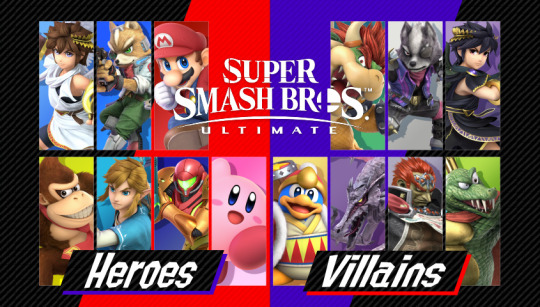
is downright ridiculous. I’m glad Nintendo is emphasizing Pit as one of the Core Smash Bros Characters and all, but this is ignoring everything about Dark Pit’s character for the sake of giving Pit someone to fight.
The whole point is that all of Pit’s darkness concentrated into one person still isn’t enough to create a villain. How often does that happen in these scenarios?
And probably the worst part is that this is only going to fuel the misunderstanding in the Smash Bros fandom. People who haven’t played Uprising are going to look at this and go “yeah, that makes sense.”
And that’s really frustrating. People have written/drawn Dark Pit out of character even without evidence to back it up, and I’m not sure this fandom is quite big enough to balance that out.
So, uh. I have infinite Kid Icarus rambling power and should probably stop here. Long story short, I totally get where you’re coming from. And I hope that this post maybe helped other people understand their characters a bit better, because they’re really awesome when you take a moment to look at them closer.
168 notes
·
View notes
Note
what is your writing process like? how long does it take you to develop the story-line and to actually sit down and write? i have some cute Namjoon fic ideas, but i don't want to start something and then fizzle out part way through....how do you maintain your motivation? ❤️the Ji to your Hope anon ❤️
This is going to be a really long answer, so I’m going to cut it with a “Keep Reading.” If you have any problem seeing the part below, please let me know and I can make other arrangements 😊
ALRIGHT. So first things first, I apologize in advance if I sound pretentious. At all. It’s definitely not my intention. The following comes from a place of my passion for writing and I hope that whatever meaning you derive from it can help in your own journey of literary exploration!
Now, as you probably know, I’m an English major working on an emphasis in creative writing. I’ve taken a few creative writing courses and have bumped elbows with a lot of brilliant writers. Below I will compile an answer based off of my experience in those classes mixed with my opinion. If you would like an elaboration on any part, please let me know and I will be more than happy to explain.
1) my writing process
Honestly? All of my life, I’ve kind of just started writing. This doesn’t seem like very helpful advice, so let me explain 😂 Once you find a source of inspiration, no matter how small or seemingly insignificant, don’t throw it away. You never know what kind of story it will blossom into. For example, it could be something as interesting as the night out that lead to my story “Deep Down, Inside” or something as simple as, say, frustration at how good a person looks when they’re a strawberry blond so gosh darn it now you’re writing a whole entire series about it and people seem to like it for whatever reason and what the HELL it’s now like the most popular thing on your blog- but yeah. Catalogue things that inspire you even if only in bullet points in a list on your phone 😄
STEP 2) after finding your inspiration. Start writing. It’s just that simple. You can always delete or edit an introduction later. If you’re interested in quick “getting started on a story” tips, just ask! And once you start writing, don’t stop. In the words of Ron Carlson, “don’t leave the room” literally or figuratively. You’ll want to look up names, definitions, get a cup of coffee, etc. DON’T DO IT! Those can be done later 😉 Often times our biggest weakness when it comes to writing is DISTRACTIONS. The more you leave, the less you’re writing. And the less time you spend writing, the harder it’ll be to remember your inventory (a word that will be elaborated upon later).
Now, this all stems from my belief that the writer should not force a narrative to go somewhere. Essentially, the author should have a conversation with their story, not guide or corral it. This allows for genuine character development and interesting, unexpected plot twists (ironic, I know, but you have to admit that in some stories, certain “plot twists” are completely expected). I will elaborate on this more momentarily.
Essentially, my writing process is: after finding something inspiring, I open up a document and start typing. Then keep typing. Don’t edit. You’re not there to be an editor. You’re there to write. Everything else comes later.
2) How long does it take me to develop the story line and to actually sit down and write?
Well... my life is kind of sad in such a way that I cannot live without writing. I go through literal withdrawals and depressions. I approach it like an art, like a part of myself. It may sound dramatic and it totally is, but words just burn me until they get out of my head. So it’s relatively, ridiculously easy in a way that’s really unfair when I’m giving advice for me to have ideas. It’s almost a detriment 😅 To answer the question directly, personally, I have two approaches to planning a story line.
1) I have no idea what the heck I’m doing and I write only what the story seems to want (see Goldilocks). This allows for more genuine characters as I let them speak instead of me speaking for them. Their dialogue, in my mind, becomes the words of a real person with real dreams and real aspirations and real motives (yes, I say this word addressing its negative connotations too). This option also makes writing a lot more fun for you as the author! 😄 why? Because every surprise for the reader is also a surprise for you~
2) The second option, my only other approach because I am a pendulum person, is elaborately planning out the plot (see Without You: Bloodstone). This can often be exhausting and intricate, obviously taking a lot of time and effort on your part to make sure every little detail matters. I do not recommend this for people who want to write casually/sensationally/shallowly for lack of better word. I’m not saying that these are any worse or less nor greater or better than deep, rhetorical writing 😊 it’s like different tastes in foods~ we each lean a certain way and it’s good to dabble in the other style every so often but let’s not kill ourselves over it, yeah?? (sensational vs. rhetorical readers/writers- a term I came up with- is a whole different conversation). ANYWAY! Bloodstone, as my primary example, took me a week in total to brainstorm. At least... the general lore stuff. The plot itself mostly stays true to my “making it up as I go along” motto, just with a few set plot points as guides. Essentially, I build the world my characters live in, give them a problem to solve, and then let them solve it on their own terms instead of mine.
Hopefully that makes sense? 😂 obviously, these are not the only two approaches and they are on a spectrum. I highly recom”mend you find a place on it that’s comfortable for you 💖
3) how do I maintain motivation?
Again, writing to me is an art. It’s something that I have to do in order to be a happy, functioning human being. So my answer might be a little unfair... and I apologize for that. I’ll thus try to approach the question objectively.
First, I’ll pull back what I said earlier, “Essentially, the author should have a conversation with their story, not guide or corral it...This option also makes writing a lot more fun for you as the author! 😄 why? Because every surprise for the reader is also a surprise for you~”
If you’re having fun while writing, it’s a lot easier to keep writing, no? If you know exactly what’s going on at all times, it gets boring. If it’s already panned out in your imagination, why write it at all? To get notes? I will always be an advocate of “write for yourself first and foremost.” This also makes the story more enjoyable for you.
Second, I’m going to address the dreaded writer’s block. A lot of people will say “set the story aside and come back to it later.” To that, I retort with, “No don’t you dare do that because you and I both know you’ll probably never pick it up again.” STAY IN THE ROOM (to quote Ron Carlson). I believe that one of the biggest causes of writer’s block is not knowing where to go. This is a fair observation, yes? Your brain basically says “yup. This story has reached a dead end” and “dead end” translates to “conclusion,” a rather frustrating imaginary/subconscious “the end” even if you feel like you still have more plot points to reach.
But Kay, what do I do to get myself out of this?
If you want to save your story, it’s time to do some editing! Well, okay, maybe not editing, but rereading. You need to take an inventory. Key word, remember it. INVENTORY. This is a literal list of physical objects, characters, and plot points/loose ends. If you write on the fly, there will sometimes be items that appear. You’ll have no idea why they’re there. A lanyard, a book, something as random as a spatula? Sure. If it appears in your story it might be useful later. These are physical objects that your brain can attach to and can move around in your story’s world. Maybe that lanyard thrown so haphazardly into a physical description of the love interest’s backpack becomes a telltale sign that it was them that left that anonymous love letter in your protagonist’s desk because it’s now wrapped up inside. Maybe that book you mentioned when describing the setting turns out to belong to your protagonist’s grandfather and helps them figure out the mysterious anagram that had been left in a dusty diary found in the attic. Maybe that spatula so casually used to make brownies during an interview turns out to be the murder weapon. YOU NEVER KNOW.
I’m going to lump characters and plot points/loose ends together simply because I feel like this is getting hella long (whoops). Personally, I’ve learned how to notice loose ends while I’m writing and will keep a bulleted list of questions or things to be resolved at the end of the document so that I can see it while I’m writing. This lengthy list will often have character names and important traits/facts as well (example: did you mention an age? a day of the week? a season? Did your character ever text back that one dude?). And if you feel like you’re missing something or running low, go back and reread. Your inventory can always increase.
This list will be a lifeline when stuck with writer’s block. You need to resolve SOME of these issues that are now (thank GOODNESS) explicitly listed right in front of you. Even if it doesn’t feel like you’re moving along to your next planned plot point, who cares? 😄 Maybe your story doesn’t want to go there!
And in the end, it is my belief that your story will sound more genuine, more real if you let it speak to you.
I hope this helped! And I look forward to being able to see your fic 😊 keep me posted on how it’s going and if you need any help brainstorming or just want to discuss creative writing in general, I am always down for that.
Much love ~🐰 xx
4 notes
·
View notes
Text
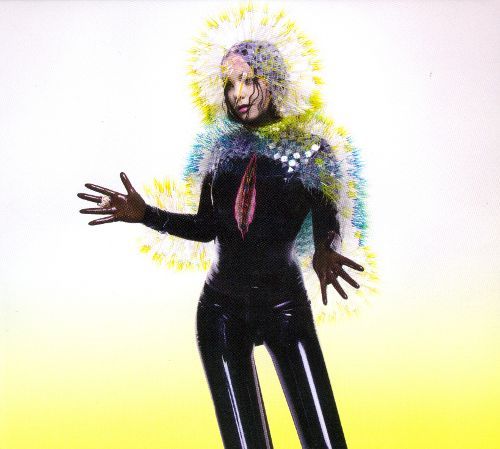
Inventive, brazen and unapologetic, Icelandic singer Bjork turns a teardrop into a thunderstorm and a smile into a beam. Her albums “Debut,” “Vespertine” and “Vulnicura” challenge listeners to see the world from an emotional point of view. As pivotal examples of Bjork’s most gripping work, each album is emotionally reflective on the roles Bjork has impressively juggled over the years as a mother, lover and acclaimed international musician.
“Debut,” with its driving rhythms and powerful lyrics, introduced the world to the energetic, 28-year-old mother. “Vespertine” breached the Outkast-Destiny’s Child-’NSync-laden charts with its electronic and avant-garde use of household sounds and Inuit choruses. 14 years later on “Vulnicura,” Bjork mourns over her divorce with Matthew Barney in a devastatingly beautiful narration of their disintegrated relationship.
Bjork was raised in a broken family. Her parents divorced in 1966, only a year after her birth. She lived with her mother, Hildur Hauksdóttir, a homeopathic doctor and martial arts teacher. Conscious of her daughter’s creative gift, Hildur enrolled Bjork in music school at the age of five.
Bjork released her first EP of children’s music at age 11, gaining her popular recognition in Iceland. She caught the punk rock and new wave bugs in her teenage years, forming groups Exodus, Tappi Tikarrass and KUKL.
In 1986, KUKL evolved into The Sugarcubes, a full-blown psychedelic rock band featuring Bjork on vocals, her then-husband Thor Eldon on guitar and Bragi Olafsson on bass. The Sugarcubes signed with Elektra Records (The Doors, The Stooges) in the U.S. and with One Little Indian Records (Asgeir, Olga Bell) in the U.K.
The Sugarcubes’ debut “Life’s Too Good” (Elektra, 1988) stormed the U.S. and the U.K., pleasing both college radio audiences and white-collar critics. The single “Birthday,” an eclectic David Byrne meets Liz Phair track, became a crossover radio hit, exposing conventional audiences to Bjork’s distinctive vocal styling.
The Sugarcubes put Iceland on the music map. Suddenly, the media became attentive to the island country way before the Kardashians vacationed there.
“Debut” was released in July 1993. A blend of jazz, house and trip-hop “Debut” jangles with contemporary rhythms. Although many of the tracks were pre-written by the teenage Bjork, “Debut” is a mature dance album sophisticated enough to spin in a city club, yet unassuming enough to play at a neighborhood block party. A showcase for her creative technical abilities, allmusic.com describes “Debut” as an album of “emotional pop songs.” Perhaps Bjork’s most diversely themed albums, “Debut” spans a range of subjects.
The opening track of “Debut,” “Human Behavior,” is one of Bjork’s greatest earworms. With its up-tempo groove, sporadic strings, and commentary on humanity, “Human Behavior” is reminiscent of The Talking Heads’ “Road to Nowhere” (“Little Creatures” 1985). In “Human Behavior” Bjork expresses her discomfort with humans from an animal’s perspective. In a Q&A with The Guardian, Bjork revealed that “Human Behavior” was inspired by her childhood, when she felt more comfortable being in nature alone than in the company of other humans. An insight into Bjork’s alternative perspective on the world, “Human Behavior” is a rousing statement of nonconformity.
In her lyrics “If you ever get close to a human and human behavior/Be ready, be ready to get confused and be in my head after/There’s definitely, definitely, definitely no logic to human behavior” Bjork uses anaphoric techniques to reiterate her frustration with the irrationality of human behavior. Whether intentionally or unconsciously utilized, this technique causes the animal protagonist appears to have a stutter, further conveying her uneasiness surrounding human behavior.
On “There’s More to Life Than This,” Bjork channels her teenage restlessness into an angsty disco call to find more meaning in life. She sings, “Come on girl/Let’s sneak out of this party/It’s getting boring/There’s more to life than this.” An allusion to a theme on her album “Vespertine,” “There’s More to Life Than This” is consistent with her desire to break the status quo, and is an indication into Bjork’s dissatisfaction with everyday life. The production on this track is exciting; the clamor of voices sustained in the background are reminiscent of Marvin Gaye’s “What’s Going On” and a background hook similar to Michael Jackson’s “Wanna Be Startin’ Somethin’” makes one feel like they are in a room full of action. The lyrics and production contribute to the song’s overall anticipatory and anxious feel, adding to the lively spirit of “Debut.”
Furthermore, a boy who saw everything from a naturalistic point of view inspired “Venus As a Boy.” Bjork describes the boy’s point of view as a "beauty point of view, and not superficial beauty but the beauty of brushing your teeth and the beauty of waking up in the morning in the right beat and the beauty of having a conversation with a person." A sweet song, innocent in arrangement but perverse in lyrics, describes the boy’s desire: “He’s exploring/The taste of her/Arousal/So accurate/He sets off/The beauty in her/He’s Venus as a boy.” The song plays with perspective, mythology and gender in a fascinating approach to uninhibited sexuality, a subject Bjork has never been shy about. For 1993, “Venus As a Boy” was ahead of its time in terms of women expressing their sexuality. Tactfully executed, the song makes a brilliant public statement about being comfortable with one’s sexuality.
The sexual tones in Bjork’s music continue on “Vespertine,” the experimental album of an already-established experimental artist. The album sounds like a cyborg Bjork typing on a laptop while suspended in space. Musically, “Vespertine” has fewer climaxes and declines than “Debut,” creating a melancholy mood throughout the album. Intentionally monochromatic, the album’s working title was “Domestika,” as Bjork originally wanted to celebrate the triteness of everyday life through what she referred to as “domestic” moods and noises translated into melodies and beats. Lyrically, the album delves into sex and love, and “Vulnicura” meaning “relating to, occurring, or active in the evening” replaced “Domestika.”
“Cocoon,” the album’s second track, describes making love though explicit and metaphorical sensations. Bjork fluctuates between metaphors like, “Who would have known that a boy like him/Would have entered me lightly restoring my bliss” and direct lines such as “He slides inside/Half awake half asleep/We faint back into sleephood/When I wake up the second time in his arms/Gorgeousness, he’s still inside me!” This kind of honest and erotic vulnerability is empowering to women because it rejects the sexual double standard in which men are encouraged to express their sexuality and women are told to repress it. Female interpretations on sex, though few, are hardly celebrated in the art world.
Bjork continues to address intimacy in “Hidden Place.” In an interview with CDNow.com, she explained the song: “'Hidden Place' is sort of about how two people can create a paradise just by uniting. You've got an emotional location that's mutual. And it's unbreakable. And obviously it's make-believe. So, you could argue that it doesn't exist because it's invisible, but of course it does.” Poetic verses such as, “He’s the beautifullest, fragilest, still strong/Dark and divine/And the littleness of his movements/Hides himself/He invents a charm that makes him invisible/Hides in the hair/Can I hide there too? /Hide in the hair of him/See solace/Sanctuary” magnify the extraordinary bliss of being close to someone. Though a relatable human experience, Bjork’s abstract interpretation further elucidates the extent at which one can feel affectionate, shedding light on what it is that can make a relationship so special.
The album’s mood brews In “Pagan Poetry,” a sorrowful lament about unrequited love. Bjork utterly exposes herself at the four-minute mark when the swirling ambient tones drop, leaving Bjork singing, “I love him, I love him/I love him, I love him/I love him, I love him.” Though she repeats this over and over, her inflection makes the phrase sound almost like a question, as if she is unsure of this statement and is trying to find some sort of meaning in it. In contrast to her warmth in “Cocoon” and “Hidden Place,” “Pagan Poetry” is full of tension as Bjork wrestles with entrapment of idealization.
“Vulnicura,” Bjork’s most recent album, is an intense fifty-nine minutes of Bjork’s feelings before and after her breakup with Matthew Barney. Listeners have heard Bjork be vulnerable before, but on “Vulnicura” she bares her soul, grieving over the loss of her relationship. It is important to note that the majority of Bjork’s work is told from an omniscient point of view. On “Vulnicura,” Bjork speaks from the first person, a telltale sign that she wants to connect with people and that she trusts them with her most personal feelings.
What sets “Vulnicura” apart from other breakup albums is Bjork’s ability to make even her most personal experiences speak to the whole world. Bjork’s work over the past thirty years, often viewed by the mainstream as complex and inaccessible, did not always achieve worldwide relatability and affirmation. However, “Vulnicura” is a straightforward deliverance of heartbreak without much room for interpretation as the facts surrounding the relationship are contained in the album’s lyrics. In her handwritten note announcing the album’s release, Bjork wrote, “Hopefully these songs could be a help, a crutch to others and prove how biological this process is: the wound and the healing of the wound, it has a stubborn clock attached to it."
The album’s concise lyrics and accompanying string arrangements create an invisible connection that wraps listeners up. There is something so relatable about the simplicity of music and lyrics, and all one has to do is close his or her eyes and let the music carry him or her on a journey. With seven out of nine songs on the album being over six minutes long, the strings serve as necessary storyline cues, introducing moments and characters and guiding the storyline. They weave in and out with Bjork’s libretto-style singing, and there are times when Bjork pauses and allows the strings to respond, carrying the story on their own. With her string arrangements brought to front with her vocals, the strings become Bjork’s comfort in her despair and a listener’s safety net on his or her journey.
Thematically, the first three songs on “Vulnicura,” “Stonemilker,” “Lionsong” and “History of Touches” are about Bjork’s pre-heartbreak. In “Stonemilker,” Bjork sings, “Show me emotional respect/And I have emotional needs/I want to synchronize our feelings.” Addressing Barney, Bjork asks for him to cooperate with her to save their relationship. She wants to try, and she blames their disconnect on timing, singing “A juxtaposition in fate/Find our mutual coordinates.” Interestingly, she also states, “Moments of clarity are so rare/I better document this.” In the line, “I better document this,” she sums up the goal all of her work, to preserve emotional experiences.
Similar to “Vespertine’s” “Pagan Poetry,” “Lionsong” is a song about rejected love: “Maybe he will come out of this loving me/Maybe he won’t,” Bjork sings, acknowledging that the relationship may be beyond repair. “Lionsong,” listeners hear Bjork admit for the first time that she doesn’t know what to do with her feelings: “These abstract, complex feelings/I just don’t know how to handle them/Should I throw oil on one of his moods? But which one?”
“History of Touches” once again establishes Bjork’s emphatic reverence for intimacy. The song, long past eroticism and nestled deep in former unity, is foreboding, signaling that everything is about to change. Bjork sings, “I wake you up/In the night feeling/This is our last time together.” The suspension held throughout this song is almost too painful for the heart to bear, as final moments with significant others can be some of the saddest memories.
The next three songs, “Black Lake,” “Family” and “Notget” tackle Bjork’s heartbreak after the breakup. “Black Lake” is Bjork’s diss track at Barney, in which she releases her fury about being scorned at, and about her newly severed family. She sings, “Family was our sacred mutual mission/Which you abandoned.” In her fury, she also describes her wound as a big hole in her chest, as depicted on “Vulnicura’s” cover. She sings, “I am one wound/My pulsating body/Suffering being/My heart is an enormous lake/Black with potion/I am blind/Drowning in this ocean/My soul is torn apart/My spirit is broken/Into the fabric of all/He is woven.”
“Family” one of the album’s darkest songs, is Bjork’s elegy to her separated family. Written six months after her breakup, Bjork mourns, “Is there a place/Where I can pay respects/For the death of my family/Show some respect/Between the three of us/There is the mother and the child/Then there is the father and the child/But no man and a woman/No triangle of love.” Full of disappointment and misery, “Family” reveals more to listeners about Bjork’s expectations for herself as a mother and for Barney as a father. Because she grew up in a detached household, Bjork desired a stable home and family for her and Barney’s daughter. This is another one of Bjork’s pleas to Barney to respect her and their family by participating in the family they created together.
In “Notget,” written 11 months after the breakup, listeners hear a very uneasy Bjork try to make peace with her pain through the declaration that the split has changed her forever but she has to move on and grow from her despair. She sings, “If I regret us/I’m denying my soul to grow/Don’t remove my pain/It is my chance to heal.”
The three final songs, “Atom Dance,” “Mouth Mantra” and “Quicksand” are attempts at situational acceptance. The album concludes on Bjork’s somewhat positive belief that life must go on.
What’s magnificent about Bjork is her supernal ability to translate human emotion into colossal and sophisticated works of art. Even more than acknowledging feelings, Bjork pushes human sensations past the realm of reality, redefining them by her own mythological terms. Listening to Bjork requires one to analyze his or her experiences through conceptual questions like: What is the capacity of a feeling? How can abstraction affect the magnitude of an emotion? In which format will the intensity of an emotion be most accurately conveyed? How can I fulfill this emotion?
If listeners are up for the challenge, they will find comfort in this process. As shown in the line, “I better document this” from “Vulnicura,” even the most agonizing situations can make for meaningful material. As Bjork’s work proves, expression is a lifelong introspective process that serves as therapy not only for oneself, but for others as well.
0 notes